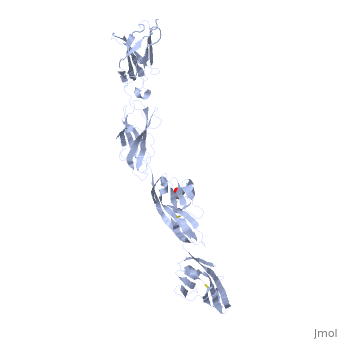5i99
From Proteopedia
(Difference between revisions)
| (3 intermediate revisions not shown.) | |||
| Line 1: | Line 1: | ||
| - | '''Unreleased structure''' | ||
| - | + | ==Crystal structure of mouse CNTN3 Ig5-Fn2 domains== | |
| + | <StructureSection load='5i99' size='340' side='right'caption='[[5i99]], [[Resolution|resolution]] 2.40Å' scene=''> | ||
| + | == Structural highlights == | ||
| + | <table><tr><td colspan='2'>[[5i99]] is a 1 chain structure with sequence from [https://en.wikipedia.org/wiki/Mus_musculus Mus musculus]. Full crystallographic information is available from [http://oca.weizmann.ac.il/oca-bin/ocashort?id=5I99 OCA]. For a <b>guided tour on the structure components</b> use [https://proteopedia.org/fgij/fg.htm?mol=5I99 FirstGlance]. <br> | ||
| + | </td></tr><tr id='method'><td class="sblockLbl"><b>[[Empirical_models|Method:]]</b></td><td class="sblockDat" id="methodDat">X-ray diffraction, [[Resolution|Resolution]] 2.4Å</td></tr> | ||
| + | <tr id='ligand'><td class="sblockLbl"><b>[[Ligand|Ligands:]]</b></td><td class="sblockDat" id="ligandDat"><scene name='pdbligand=GOL:GLYCEROL'>GOL</scene></td></tr> | ||
| + | <tr id='resources'><td class="sblockLbl"><b>Resources:</b></td><td class="sblockDat"><span class='plainlinks'>[https://proteopedia.org/fgij/fg.htm?mol=5i99 FirstGlance], [http://oca.weizmann.ac.il/oca-bin/ocaids?id=5i99 OCA], [https://pdbe.org/5i99 PDBe], [https://www.rcsb.org/pdb/explore.do?structureId=5i99 RCSB], [https://www.ebi.ac.uk/pdbsum/5i99 PDBsum], [https://prosat.h-its.org/prosat/prosatexe?pdbcode=5i99 ProSAT]</span></td></tr> | ||
| + | </table> | ||
| + | == Function == | ||
| + | [https://www.uniprot.org/uniprot/CNTN3_MOUSE CNTN3_MOUSE] Contactins mediate cell surface interactions during nervous system development. Has some neurite outgrowth-promoting activity (By similarity). | ||
| + | <div style="background-color:#fffaf0;"> | ||
| + | == Publication Abstract from PubMed == | ||
| + | Protein tyrosine phosphatase receptor type G (RPTPgamma/PTPRG) interacts in vitro with contactin-3-6 (CNTN3-6), a group of glycosylphosphatidyl-anchored cell adhesion molecules involved in the wiring of the nervous system. In addition to PTPRG, CNTNs associate with multiple transmembrane proteins and signal inside the cell via cis-binding partners to alleviate the absence of an intracellular region. Here, we use comprehensive biochemical and structural analyses to demonstrate that PTPRG[middot]CNTN3-6 complexes share similar binding affinities and a conserved arrangement. Furthermore, as a first step to identifying PTPRG.CNTN complexes in vivo, we found that PTPRG and CNTN3 associate in the outer segments of mouse rod photoreceptor cells. In particular, PTPRG and CNTN3 form cis-complexes at the surface of photoreceptors, yet interact in trans when expressed on the surfaces of apposing cells. Further structural analyses suggest that all CNTN ectodomains adopt a bent conformation and might lie parallel to the cell surface to accommodate these cis and trans binding modes. Taken together, these studies identify a PTPRG.CNTN complex in vivo and provide novel insights into PTPRG- and CNTN- mediated signaling. | ||
| - | + | Structural Basis for Interactions Between Contactin Family Members and Protein Tyrosine Phosphatase Receptor Type G in Neural Tissues.,Nikolaienko RM, Hammel M, Dubreuil V, Zalmai R, Hall DR, Mehzabeen N, Karuppan SJ, Harroch S, Stella SL, Bouyain S J Biol Chem. 2016 Aug 18. pii: jbc.M116.742163. PMID:27539848<ref>PMID:27539848</ref> | |
| - | + | From MEDLINE®/PubMed®, a database of the U.S. National Library of Medicine.<br> | |
| - | [[Category: | + | </div> |
| - | [[Category: | + | <div class="pdbe-citations 5i99" style="background-color:#fffaf0;"></div> |
| - | [[Category: Bouyain | + | == References == |
| + | <references/> | ||
| + | __TOC__ | ||
| + | </StructureSection> | ||
| + | [[Category: Large Structures]] | ||
| + | [[Category: Mus musculus]] | ||
| + | [[Category: Bouyain S]] | ||
| + | [[Category: Nikolaienko RM]] | ||
Current revision
Crystal structure of mouse CNTN3 Ig5-Fn2 domains
| |||||||||||

